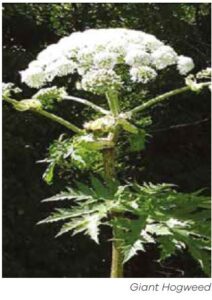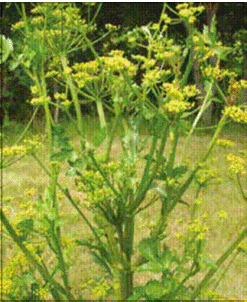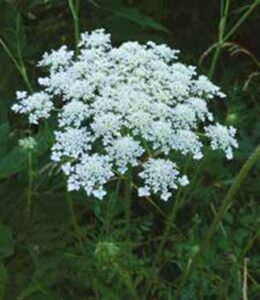PPD occurs when the sap from the broken stems and leaves of certain plants touch the skin which is then subsequently exposed to ultraviolet light (still produced if the weather is cloudy).
Within 24-48 hours the affected area will first redden and, in most cases, be followed by blisters that can be painful for a couple of days.
In many cases the blisters will lead to a brownish pigmentation that can remain on the skin for years.
Brush cutting these plants creates a high risk of spray of the sap and likely skin exposure. Look for their presence on site when conducting point of work risk assessments. More information can be found in our Toolbox Talk TT/06. Below are the details of plants known to cause this reaction:
Giant Hogweed
Giant Hogweed grows up to 5 metres tall. The stem starts growing in March/ April and is green but develops dark red/purple spots or blotches during the summer. Leaves are dark green, have deeply cut lobes with ragged edges, can be 1 metre across and form in a rosette.
Flowers are white, umbrella-like and up to 500 mm across and appear from June in the fourth year.
• Avoid environmental harm: As it spreads, it endangers the survival of native plants. The loss of other vegetation may lead to excessive
erosion of soil as the Giant Hogweed dies back in winter.
• Avoid prosecution: It is illegal ‘to plant or otherwise encourage’ the growth of Giant Hogweed. This could include moving surrounding soil which may contain either seeds or plant material unless as part of an eradication process.
Wild Parsnip
Wild Parsnip lives for two years. The first year as a spindly rosette close to the ground. In the second year a hollow, grooved stalk rising 0.6-0.8 metres high. Flowers are yellow and flat topped umbrella-like clusters at the top of the plant. Wild Parsnip rosettes are among the first plants to become green in spring and its flowers turn a prominent yellow in midsummer. Wild Parsnip is often found in roadsides, abandoned fields, unmown pastures and edges of woodlands.
Wild Carrot
The wild carrot is a herbaceous, somewhat variable, biennial plant that grows between 0.3 and 0.6 metres tall,
roughly hairy, with a stiff solid stem. The leaves are tri-pinnate, finely divided, lacy and overall triangular in shape. The flowers are small and dull white, clustered in flat, dense umbels. They may be pink in bud and there may be a reddish flower in the centre of the umbel. The lower
bracts are three-forked or pinnate, a fact which distinguishes the plant from other white flowered umbellifers.






